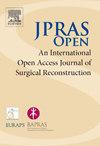脊髓刺激试验可控制慢性肢体缺血引起的疼痛
IF 1.5
Q3 SURGERY
引用次数: 0
摘要
背景慢性肢体缺血患者在溃疡治疗期间会经历长时间的疼痛。因此,止痛药会逐渐增加,但经常会出现不良反应。研究在春日部中央综合医院的肢体救治中心进行。共有 41 名患者接受了为期 2 周的脊髓刺激试验,平均年龄为 70.4 ± 9.58 岁。其中男性 33 人(80%),女性 8 人(20%)。对数字评分、伤口效果、脊髓刺激相关不良事件和口服止痛药总剂量进行了评估。数字评分从脊髓刺激前的 7/10 分提高到脊髓刺激后 2 天的 2/10 分(P < 0.001)。结论脊髓刺激疗法可在短期内改善数字评分,因此推荐用于外周动脉疾病。因此,这种试验方法可以在不进行植入手术的情况下充分控制慢性肢体缺血引起的疼痛。本文章由计算机程序翻译,如有差异,请以英文原文为准。
Spinal cord stimulation trial can control pain caused by chronic limb-threatening ischemia
Background
Patients with chronic limb-threatening ischemia experience long-duration pain during ulcer treatment. Hence, painkillers are gradually increased, but adverse events often occur. Spinal cord stimulation trial is one of the methods used to manage such pain.
Method
The study was performed at the Limb Salvage Center in Kasukabe Chuo General Hospital. Total 41 patients with mean age 70.4 ± 9.58 years underwent spinal cord stimulation trial for 2 weeks. Among them, 33 (80 %) were male, and 8 (20 %) were female. Numerical rating scores, wound results, spinal cord stimulation-related adverse events, and total dose of oral painkillers were evaluated.
Results
Postoperatively, itching and bleeding were reported. The numerical rating scores improved from 7/10 before to 2/10 at 2 days after the spinal cord stimulation (P < 0.001). The total doses of oral painkillers showed no change before and after spinal cord stimulation (P > 0.05).
Conclusions
Spinal cord stimulation is recommended for peripheral artery disease because it can improve numerical rating scores for a short term. Therefore, this trial approach can sufficiently control pain against chronic limb-threatening ischemia, without undergoing implantation.
求助全文
通过发布文献求助,成功后即可免费获取论文全文。
去求助
来源期刊

JPRAS Open
Medicine-Surgery
CiteScore
1.60
自引率
0.00%
发文量
89
审稿时长
22 weeks
期刊介绍:
JPRAS Open is an international, open access journal dedicated to publishing case reports, short communications, and full-length articles. JPRAS Open will provide the most current source of information and references in plastic, reconstructive & aesthetic surgery. The Journal is based on the continued need to improve surgical care by providing highlights in general reconstructive surgery; cleft lip, palate and craniofacial surgery; head and neck surgery; skin cancer; breast surgery; hand surgery; lower limb trauma; burns; and aesthetic surgery. The Journal will provide authors with fast publication times.
 求助内容:
求助内容: 应助结果提醒方式:
应助结果提醒方式:


